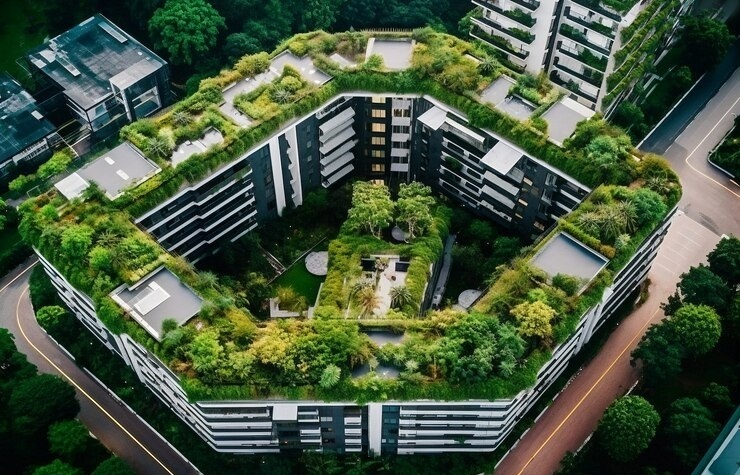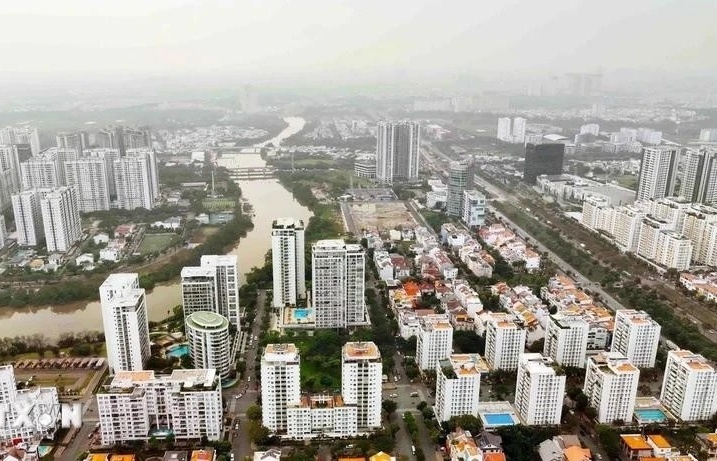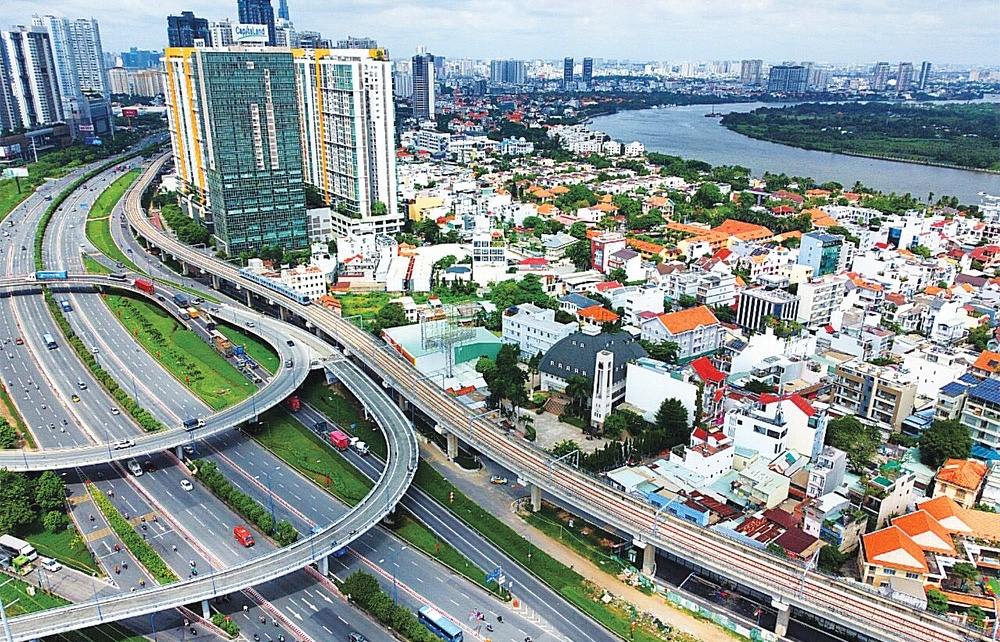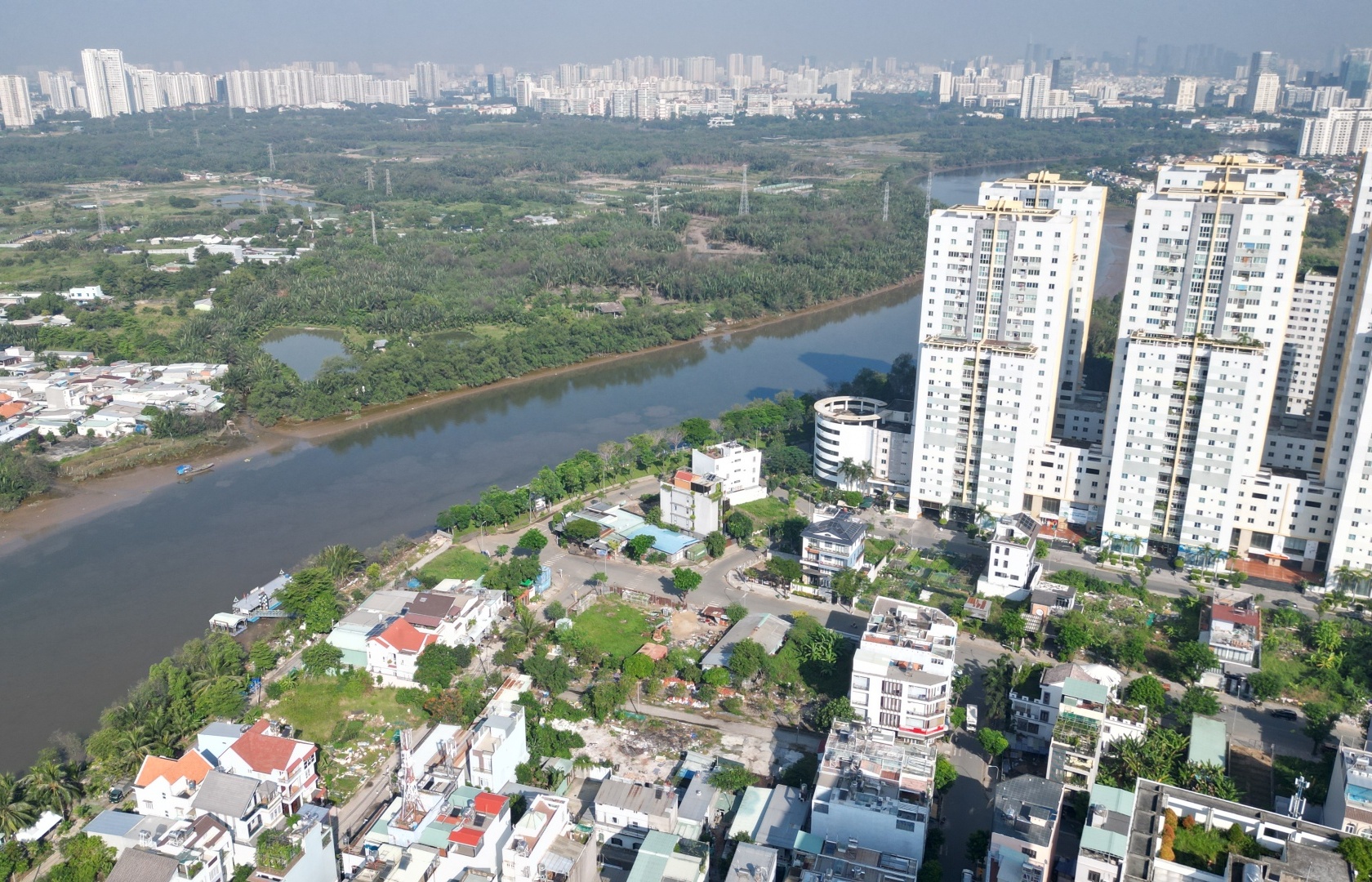Demand up, supply low but return poor
Office lessors in Ho Chi Minh City had a busy year, finding it increasingly difficult to find suitable space to offer potential tenants.Some were turning away customers because they simply had no property available.
 Onwards and upwards: construction continued in 2003 but not enough to fill burgeoning demand |
Other office properties downtown, such as Somerset Chancellor Court, the Landmark, Sun Wah Tower, Me Linh Point, Diamond Plaza, Harbour View Tower and Saigon Riverside, reported occupancy rates of 90 to 100 per cent. By contrast, office managers were finding it hard to get a customer during the Asian financial crisis in 1997.
“Recently we have had to refuse new orders for office space because our property is fully occupied,” a Sun Wah Tower executive said.
“We will able to receive new tenants only when our contracts with the current lessees expire and if they don’t want to renew.”
Office managers say the increasing demand for new office space began two years ago and is expected to continue in coming years. Tenants prefer modern office buildings due to security and other services available.
After just four months in business, 60 per cent of Bitexco, another building located in the central business district with 19 storeys covering 6,000sqm, has been filled at a monthly rate of $20 per sqm.
For the city’s suburban office market, the e.Town building in Tan Binh District which opened more than a year ago with the IT industry in mind, has also been successful. The 12-storey building has already let nearly 70 per cent of its 30,000sqm to more than 80 tenants. Two thirds of tenants are involved in the IT and high-tech sector.
The building’s A-list tenants include Silkroad, Siemens, Glass Egg, Akzo Nobel, AIA, Atlas Industries, Ballast Nedham, Citibank, Expeditors, Formosa, HSBC, ISB Japan, Nippon Engineering, Novi Footwear, Scheneider Electric, SDV, Vietcombank, VSL and San Miguel.
Nguyen Thi Mai Thanh, general director of REE Corporation, the e.Town developer, said her staff, along with the UK-backed real-estate management and marketing agent Dinning & Associates, were stepping up marketing to lure more tenants, hoping to reach an occupancy rate of 90 per cent by next April.
“There is a long list of potential customers that we are negotiating with. We hope we will sign some big deals by early next year,” she said.
As for the residential market, figures released by real-estate consulting company CB Richard Ellis Vietnam (CBRE) showed that 90 per cent of serviced apartments in 13 buildings and residential areas in Districts 1 and 3 had been leased.
In the fourth quarter alone, the average occupancy rate for grade A serviced apartments was 94 per cent with the average rental rate ranging between $20 per sqm and $30 per sqm.
In 2003, Ho Chi Minh City authorities licensed the construction of several high-rise property projects, such as the Pasteur, Veronica and Manor in downtown Ho Chi Minh City, which have attracted well-off families.
Many Viet Kieu (overseas Vietnamese) and members of the expatriate community have been drawn to centrally located apartments, with long-term lease ranging from $1,665 to $1,877 per sqm.
In November, the Hai An joint-stock company opened the Veronica residential in Thao Dien Ward, District 2, with 90-150sqm for lease.
Low returns
Despite the rise in office space occupancy, property operators claim their businesses still bring in low returns.
The main reason, according to operators, is that current rental prices remain lower than prices planned at the design stage, before the 1997 Asian financial crisis.
One square metre of grade-A office space in the city currently rents at an average $26.50-$29.70, compared to $25-$28 three months ago, but below the $30-$35 per sqm of before the crash.
Office operators say that with few office buildings opened in the last few years, existing buildings had opportunities to marginally increase rental rates. However, the surplus from the recent rise in occupancy rate and rental prices does not balance the expense of maintaining the high level of services.
The operators also said that although their office space was nearly occupied to capacity and rental was 10-15 per cent higher than last year, they still managed only 50-60 per cent of estimated profits.
“The rental price is rising but not strongly enough to reach the previously-designed price level overnight,” said an executive from Sunimex, a local partner in many city-based property projects including Saigon Tower and Renaissance, Sofitel Plaza Hotel and Norfolk Hotel.
What’s more, he said, property operators still faced difficulties with repayments on bank loans, which often accounted for 60-70 per cent of investment capital.
High demand but undersupply
Both real-estate operators and consultants believe the demands for office buildings and luxury apartments among domestic and foreign companies will remain high for two or three years as the city is in short supply of international standard office space while more multinationals are coming to the city.
“More and more companies, local and foreign alike, are moving into the convenient buildings. What’s more, a growing expatriate community and higher living standards demanded by local residents have triggered a flurry of building activity in city’s luxury apartment market.
“If the trend continues, the city is likely to face a shortage of office and apartment accommodation for foreigners and local businesses over the next few years, until new offices and apartments are put into operation,” a consultant said.
According to a CBRE forecast, the office market is expected to be strong in the next 12 months as improvement in the economic environment leads to expanded demand from local companies and new demand from small- and medium-sized foreign enterprises, although some existing companies will have to relocate to lower-grade office buildings as renewed rents exceed their initial budget.
It is expected that office rents will increase by 10 per cent in the next 12 months due to undersupply and vacancy rates will decrease by 3 per cent over the next six to 12 months.
There are 32 office buildings for rent in the city’s central business district (CBD) with a total supply of 210,000sqm. There is only an estimated 5-10 per cent office left available for lease.
With limited space available in the CBD market, property consultants expect existing buildings and new developments in the city’s suburban office market will help meet increasing demand.
These include part of e.Town in Tan Binh District and two new developments in Saigon South by Phu My Hung Corporation, namely the Gateway Building with 12,000sqm of grade A space and Broad Business Park, a phase commercial office park consisting of 16 low-rise office buildings with 25,000sqm of net area for lease.
CBRE also predicts the residential serviced apartment market will remain positive next year with relatively good demand and limited supply. Only a few new development projects will enter the market in 2004 including HBT Court and Nguyen Du Park Residences, both located in the central business district.
HBT Court is to offer 21 luxury serviced apartments which should be complete by the first quarter of 2004, while the Nguyen Du Park Residences with 41 apartments will be ready by May.
Property experts noted that prices of these high-end apartments in the city could drop significantly from 2006 as a number of property projects now under construction and thousands of serviced apartments come up for sale or lease at the same time.
“Frozen” projects to move?
Despite a positive upturn in the local property market, foreign investors in stalled property projects which were licensed before the Asian economic crisis seemed to be keeping quiet in 2003.
According to property consultants, foreign partners involved in these projects, mostly from Japan, South Korea, Singapore and Hong Kong, still face budget constraints and do not want to have to form joint ventures.
“The joint venture system has proved to have its failings and many of the stalled projects are stuck because of too-high expenses for land preparation. This means it is not feasible to go forward and impossible to sell the rights to develop without incurring losses,” said Brett Ashton, director of Chesterton Petty Vietnam in Ho Chi Minh City.
“Foreign investors will come back – indeed would already be investing – when suitable plots are released without the burden of old-style joint venture agreements and previously-incurred costs.”
As for the city’s part, municipal officials said at a recent meeting with owners of stalled property projects that the city would not allow licensed property projects, especially those which were situated on attractive downtown locations, to be delayed any longer. Proposed solutions are to withdraw licences, transfer licences to local partners or find new parties to develop the projects.
“It is necessary to create opportunities for new property investors,” a senior official said.
“The local side in joint ventures should persuade foreign partners to sell their stake if the former can find other partners who are capable of developing the projects without delay.”
According to the municipal department of planning and investment, there are 30 stalled property projects in Ho Chi Minh City, occupying a total area of 500 hectares.
What the stars mean:
★ Poor ★ ★ Promising ★★★ Good ★★★★ Very good ★★★★★ Exceptional
Latest News
More News
- North’s industrial property impresses (January 03, 2025 | 16:00)
- Authorities vow to iron out persistent delays (January 03, 2025 | 14:46)
- Country keeps pace with modern industrial property (January 02, 2025 | 14:00)
- Vietnam’s real estate market on a path to recovery (December 27, 2024 | 16:30)
- VinaLiving hands over luxury condotels at Ocean Resort Quy Nhon (December 26, 2024 | 16:13)
- Realty interest hitting the heights in Vietnam (December 24, 2024 | 16:58)
- Building a thriving community with KTG Industrial (December 24, 2024 | 11:00)
- A vibrant period on horizon for mergers and acquisitions (December 23, 2024 | 15:00)
- Merry Plaza brand announced (December 23, 2024 | 14:40)
- Big real estate deals forging ahead (December 23, 2024 | 10:52)


















 Mobile Version
Mobile Version